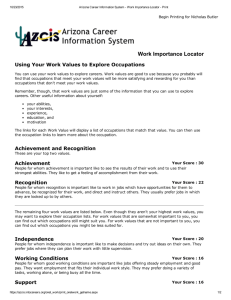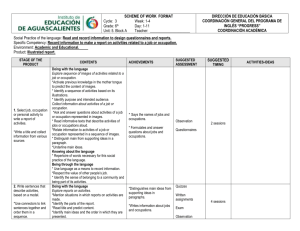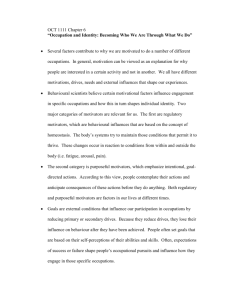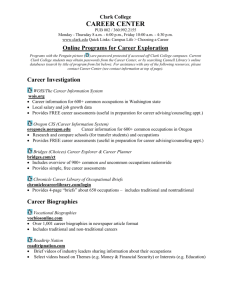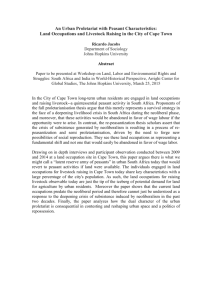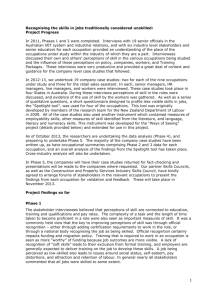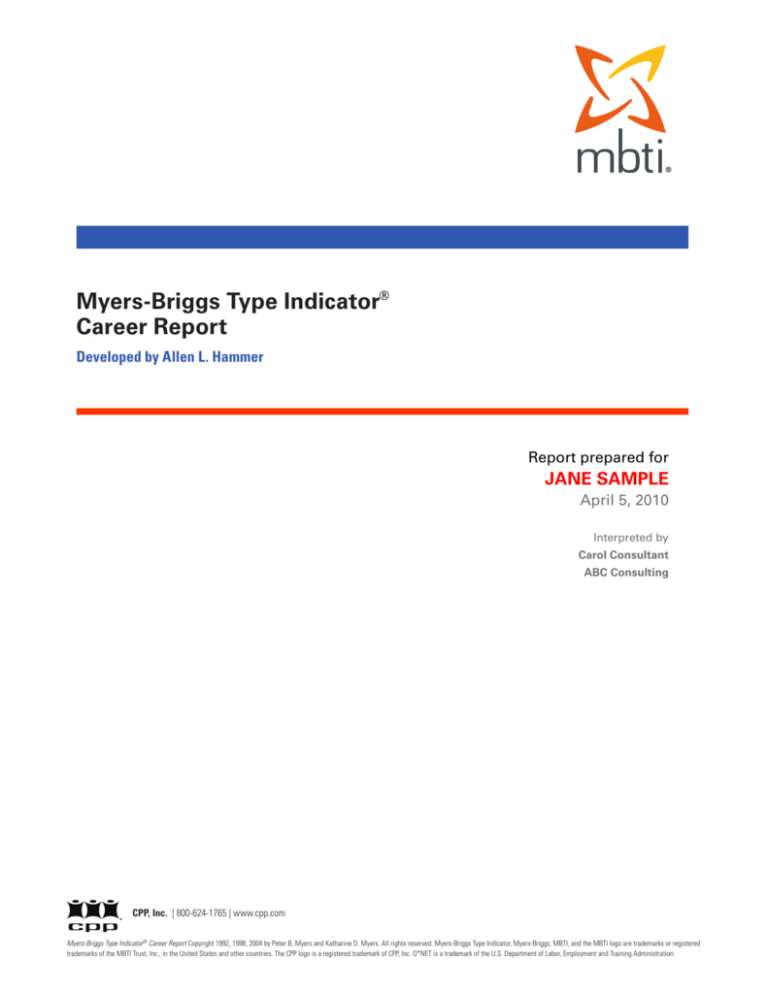
Myers-Briggs Type Indicator®
Career Report
Developed by Allen L. Hammer
Report prepared for
JANE SAMPLE
April 5, 2010
Interpreted by
Carol Consultant
ABC Consulting
CPP, Inc. | 800-624-1765 | www.cpp.com
Myers-Briggs Type Indicator® Career Report Copyright 1992, 1998, 2004 by Peter B. Myers and Katharine D. Myers. All rights reserved. Myers-Briggs Type Indicator, Myers-Briggs, MBTI, and the MBTI logo are trademarks or registered
trademarks of the MBTI Trust, Inc., in the United States and other countries. The CPP logo is a registered trademark of CPP, Inc. O*NET is a trademark of the U.S. Department of Labor, Employment and Training Administration.
Myers-Briggs Type Indicator®
Career Report
JANE SAMPLE / ENFP
Page 2
Introduction
This report applies your results from the Myers-Briggs Type Indicator® (MBTI®) assessment to help you
identify job families and occupations that are a good fit for your reported MBTI type. The MBTI
tool was developed by Isabel Briggs Myers and Katharine Briggs and is based on Carl Jung’s theory of
psychological types. It has been used for more than 60 years to help people become more satisfied and
successful in their careers.
This Report Can Help You
•
•
•
•
•
•
•
Identify job families, or broad occupational categories, to help get you started in your career search
Choose a specific job or career
Select a college major or course of study
Identify strengths and potential weaknesses of your type for the career search process
Increase your job satisfaction
Make a career transition or shift
Plan your career development strategy and action steps
The job families and specific occupations used in this report are adapted from the O*NET™ system of
occupational classification developed by the U.S. Department of Labor, which is the standard method
for classifying occupations. The relationship between the O*NET occupations and MBTI types has been
established using information from a database of more than 92,000 working adults who recently took
the MBTI assessment and reported that they were satisfied with their jobs.
This report is only one source of information. When choosing a career or contemplating a career
change, you must also consider your abilities and skills, your occupational and leisure interests, and
your values and goals. You will also need information about specific tasks involved in different
occupations, as well as current career opportunities. Additional career information can be found
online at http://online.onetcenter.org.
How Your MBTI® Career Report Is Organized
•
•
•
•
•
Summary of Your MBTI® Results
How Your Type Affects Your Career Choice
How Your Type Affects Your Career Exploration
How Your Type Affects Your Career Development
Job Families and Occupations for Your Type
Ranking of Job Families
Most Popular Occupations
Least Popular Occupations
Myers-Briggs Type Indicator®
Career Report
JANE SAMPLE / ENFP
Page 3
Summary of Your MBTI® Results
Your responses on the MBTI instrument indicate that your reported type is: ENFP.
Reported Type: ENFP
Where you
focus your
attention
Extraversion
E
The way
you take in
information
Sensing
S
The way
you make
decisions
How you
deal with the
outer world
Thinking
Intuition
People who prefer Intuition tend to take in information
from patterns and the big picture and focus on future
possibilities.
Feeling
F
People who prefer Thinking tend to make
decisions based primarily on logic and on
objective analysis of cause and effect.
Judging
J
People who prefer Introversion tend to focus on
the inner world of ideas and impressions.
N
People who prefer Sensing tend to take in
information through the five senses and focus
on the here and now.
T
Introversion
I
People who prefer Extraversion tend to focus on
the outer world of people and activity.
People who prefer Feeling tend to make decisions
based primarily on values and on subjective
evaluation of person-centered concerns.
Perceiving
P
People who prefer Judging tend to like a planned
and organized approach to life and want to have
things settled.
People who prefer Perceiving tend to like a flexible
and spontaneous approach to life and want to keep
their options open.
Your responses on the MBTI assessment not only indicate your preferences; they also indicate the relative
clarity of your preferences—that is, how clear you were in expressing your preference for a particular pole
over its opposite. This is known as the preference clarity index, or pci. The bar graph below charts your
pci results. Note that a longer bar suggests you are quite sure about your preference, while a shorter bar
suggests you are less sure about that preference.
Clarity of Reported Preferences: ENFP
Very Clear
Extraversion E
Clear
Moderate
Slight
Slight
Moderate
Clear
I Introversion
26
Sensing S
N Intuition
26
Thinking T
F Feeling
3
Judging J
P Perceiving
25
30
PCI Results
Very Clear
25
20
Extraversion 26
15
10
Intuition 26
5
Feeling 3
0
5
10
Perceiving 25
15
20
25
30
Myers-Briggs Type Indicator®
Career Report
JANE SAMPLE / ENFP
Page 4
How Your Type Affects Your Career Choice
The kinds of tasks and work environment that tend to be preferred by ENFPs are shown in the
charts below. Working at these kinds of tasks and in this kind of environment will help you feel more
comfortable and satisfied in your day-to-day work because you will have opportunities to express your
natural preferences.
Preferred Work Tasks
•
•
•
•
•
•
Helping others develop or learn
Developing multiple solutions to problems
Seeing the possibilities in any situation or person
Creating new products or services
Motivating others by conveying enthusiasm and energy
Moving quickly from one project to another
Preferred Work Environment
•
•
•
•
•
•
Offers opportunities to work with a variety of people
Provides opportunities to travel or to work with people in other countries
Encourages and rewards creativity
Has people who get excited by new possibilities
Has people with a high level of energy
Fosters teamwork
Action Steps
} Identify a specific job you are considering.
} Using an occupational library or online source such as the O*NET database (http://online.onetcenter.org),
investigate the kinds of tasks you would be doing and the kind of environment you would be working in for
this job.
} Compare these tasks and work environment to those identified for your type in the charts above.
} If there is considerable overlap, you may want to pursue this opportunity.
} If there is little overlap, you may want to rethink your plan. However, before you exclude any potential job, see
the tips found on the last page of this report.
Myers-Briggs Type Indicator®
Career Report
JANE SAMPLE / ENFP
Page 5
How Your Type Affects Your Career Exploration
How you go about exploring career options will be influenced by your ENFP preferences. Your type
will help you in your career exploration activities in distinct ways, just as it may present some distinct
challenges for you.
Your type strengths will help you:
•
Think of all the things you have ever wanted to do
Be willing to consider almost any possibility
• Take advantage of unexpected opportunities
• Establish an extensive network of people you can contact
• Convey enthusiasm and energy to interviewers
•
Challenges
Suggested Strategies
•
You may have a hard time focusing amid all the
possibilities.
•
First group all your possibilities into three categories
(e.g., high, medium, low), and then work to prioritize
those in the top group.
•
You may have no concrete action plan to help you
meet your goals.
•
Start with your goal and work backward step-bystep to the present, listing each action necessary to
achieve the next step.
•
You may spend too much time socializing rather than
networking.
•
Set a goal for how many people you will contact in a
given period or place a limit on how much time you
will spend meeting with them.
•
You may focus too much on your potential rather than
on your actual accomplishments.
•
List actual accomplishments on your resume and be
sure to convey how you can help the company now.
•
You may make decisions based on what is exciting at
the moment and neglect long-term issues.
•
Don’t make an important decision when you are too
stimulated; calm down first and reflect on what is
important.
Action Steps
} Review the list of strengths that are a natural part of your type. Make sure to rely on them as much as possible
throughout your career exploration process, especially when you are feeling anxious.
} Review the challenges related to your type. The strategies suggested for dealing with these challenges require
you to move beyond your natural comfort zone. So don’t try to overcome all these challenges at once. Pick one or
two to start with and work at them until you feel more comfortable.
Myers-Briggs Type Indicator®
Career Report
JANE SAMPLE / ENFP
Page 6
How Your Type Affects Your Career Development
Your career development process will be influenced by your ENFP preferences. Career development
almost always involves coping with new demands that do not come naturally to you and often requires
working and communicating with people with different preferences. At times, career change can be
a beneficial stimulus to further development of your type. Type development means knowing and
accepting your natural preferences and then consciously choosing to use nonpreferred preferences in
certain situations when appropriate. Listed below are some typical strengths of and challenges faced by
ENFPs, as well as some suggestions for development.
Your style has probably helped you develop strengths in:
•
Identifying and pursuing multiple possibilities
Brainstorming and creatively solving problems; developing new products or services
• Motivating others by bringing energy and enthusiasm to any task
• Communicating or selling ideas and possibilities to others
• Working closely with teams
•
Challenges
Suggested Strategies
•
You may have trouble determining priorities amid the
many possibilities you can see.
•
•
•
You may burn out from following every possibility and
overcommitting.
•
•
You may not follow through on decisions or projects.
•
Reflect quietly on what is most important to you.
Figure out what needs to be done first. What will have
the most impact?
Enroll in stress reduction or yoga classes with some
friends.
• Every time you take on a new project, ask yourself
what you will have to give up.
Ask yourself how you or others will feel if you don’t
complete this task. Who might you be letting down?
• How will you feel if you develop a reputation as
someone who doesn’t honor his or her commitments?
Action Steps
} Identify a career or job you are considering.
} Review the list of strengths and challenges above.
} Evaluate how much the job you have in mind will allow you to use your natural strengths and challenge you to
use other preferences. You will probably be most satisfied with a job that allows you to use your strengths most
of the time but also provides a manageable degree of challenge.
Myers-Briggs Type Indicator®
Career Report
JANE SAMPLE / ENFP
Page 7
Job Families and Occupations for ENFPs
The following pages of your Career Report present 22 broad occupational categories, or “job families,”
and a number of specific occupations and show how they rank in popularity among ENFPs. This
ranking is based on information from a sample of more than 92,000 people in 282 jobs who said they
were satisfied with their jobs. There were 8,305 ENFPs in this sample.
The chart on the next page shows the popularity of 22 job families among ENFPs divided into three groups:
those most attractive to ENFPs, those moderately attractive, and those least attractive. The longer the bar
on the chart, the more attractive the job family. Those job families listed as most attractive to ENFPs offer
the best opportunity for you to find an occupation in which you can use your natural preferences and be
satisfied. Those job families listed as moderately attractive may or may not offer opportunities for expressing
your preferences—it depends on the tasks and work environment of the specific occupation. Those job
families listed as least attractive are associated with occupations in which you are least likely to express your
preferences. These may require you to work “against the grain” of your preferences.
When reviewing the chart, it is important not to overemphasize the differences between any two adjacent
categories. In your career exploration process, consider all the job families in the “most attractive”
section, especially if the bars in the graph are about the same length. You should also explore job families
in the “moderately” and “least” attractive sections if they appeal to you or you would like to learn more
about them.
The following pages list specific occupations ranked by their popularity among ENFPs. The most
popular occupations are shown first, followed by the least popular.
Working with Your Job Families and Occupational Lists
•
When comparing job families and the two occupational lists, it may not be entirely clear which occupations fit
within which job families. For example, does a particular health care occupation belong in Health Care Support
or in Health Care Practitioner and Technical? To help you see the relationship, a “Career Trends” summary is
provided with your most popular occupations list.
•
If you would like more information about how job families and specific occupations are related, you can go online
to http://online.onetcenter.org and click on “Find Occupations.” On the Find Occupations page, go to the pulldown menu “By Job Family or All Occupations.” When you select one of these categories, you will be provided
with a list of all specific occupations within that category, each of which is further explained.
•
You may notice what appear to be differences between your general and specific lists. You may find a specific
occupation ranked higher or lower than you might predict based on the ranking of the corresponding job family.
This can occur because the number of specific occupations in an O*NET category ranges from 14 to 237! And
not all the specific occupations found on the O*NET database are used in your Career Report. Only those that
had a large enough sample of satisfied workers could be used. Think of the job families as an average. There will
likely be specific jobs that are a good fit for your particular preferences, even though the job family may not be all
that appealing to most persons of your type.
•
The use of job family and occupational lists should only be a first step in your career exploration process.
Myers-Briggs Type Indicator®
Career Report
JANE SAMPLE / ENFP
Page 8
Ranking of Job Families for ENFPs
Most Attractive Job Families (scores of 61–100)
0
10
20
30
40
50
60
70
80
90
Personal Care and Service
Lodging manager, personal trainer, hairdresser, child care provider
100
Arts, Design, Entertainment, Sports, and Media
Artist, coach, musician, reporter
91
Community and Social Services
Community service manager, career counselor, clergy, social worker
88
Food Preparation and Service
Chef, food service manager, bartender, host/hostess
87
Education, Library Sciences, and Training
School teacher, librarian, school administrator, university faculty
87
Sales and Advertising
Sales manager, real estate agent, insurance agent, salesperson
76
Health Care Practitioner and Technical Occupations
Pediatrician, dentist, physical therapist, lab technician
67
Health Care Support
Nurse’s aide, veterinary assistant, pharmacy aide, physical therapy aide
63
Farming, Fishing, and Forestry
Rancher, farmer, agricultural inspector, fisher
62
Moderately Attractive Job Families (scores of 41–60)
0
10
20
30
40
50
Office and Administrative Support
Bank teller, receptionist, clerical services, legal secretary
70
80
90
100
60
70
80
90
100
53
Legal
Lawyer, arbitrator, paralegal, court reporter
51
Construction and Extraction
Carpenter, plumber, electrician, stonemason
49
Building and Grounds Maintenance
Gardener, tree trimmer, housekeeping, lawn service supervisor
45
Business and Finance
Operations, finance, marketing, human resources
43
0
10
20
30
Protective Services
Firefighter, correctional officer, security guard, police officer
37
Transportation and Materials Moving
Pilot, air traffic controller, driver, freight handler
36
Installation, Maintenance, and Repair
Office machine repair, mechanic, line installer, electronics repair
35
Computers and Mathematics
Programmer, systems analyst, database administrator, mathematician
Military Specific
Air crew officer, command & control, radar operator, infantry member
60
57
Life, Physical, and Social Sciences
Biologist, chemist, economist, psychologist
Least Attractive Job Families (scores of 0–40)
100
32
28
Production and Manufacturing
Machinist, cabinetmaker, inspector, power plant operator
26
Architecture and Engineering
Architect, surveyor, mechanical engineer, chemical engineer
25
40
50
Myers-Briggs Type Indicator®
Career Report
JANE SAMPLE / ENFP
Page 9
Most Popular Occupations for ENFPs
The occupations listed below in rank order are a sampling of those that are most attractive to ENFPs.
Individuals of this type are found in these occupations in much greater proportion than would be
expected based on the frequency of this type in the general U.S. population. You are likely to find these
occupations most satisfying because you will:
•
Have opportunities to express your preferences
• Be recognized and rewarded for using your natural gifts and strengths
• Face tasks and problems you find interesting and challenging
Career Trends for ENFPs
There are two major trends in the occupations that appeal to ENFPs. Most of the popular occupations involve
working with people by providing counseling, personal or spiritual services, or teaching, or by helping them feel or
look better. The other group of popular occupations is in the arts; ENFPs are attracted to a variety of roles in this
area. There are also two occupations that involve taking care of the environment.
Most Popular Occupations for ENFPs
1
2
3
4
5
6
7
8
9
10
11
12
Craft artist
Actor/performing artist/dancer
Photographer
Forester
Musician, singer, music director, composer
Clinical/counseling/educational psychologist
Mental health counselor
Fitness trainer
Bartender
Artist/visual artist
Hairdresser, cosmetologist, manicurist,
skin care specialist
Restaurant host/hostess
13
14
15
16
17
18
19
2 0
21
2 2
2 3
24
Clergy
Travel agent/services
Career counselor
Vocational rehabilitation counselor
Preschool/kindergarten teacher
School counselor
Landscape architect
Producer, director
Psychiatric/substance abuse social worker
Adult education teacher
Receptionist
Child care worker
Action Steps
} Visit a career library and search for careers in the fields highlighted in the Career Trends box above. Write down
job titles that seem to match these trends. Then proceed to the next step to look up detailed information about
these careers.
} Go to http://online.onetcenter.org and click on “Find Occupations.” Enter the name of any of the specific
occupations listed above, or any other occupation that interests you, in the “By Keyword” box. This will lead you
to comprehensive and detailed information about that occupation, including the knowledge, skills, and abilities
needed to perform the job, the educational and training requirements, and the employment outlook for that
occupation by state.
Myers-Briggs Type Indicator®
Career Report
JANE SAMPLE / ENFP
Page 10
Least Popular Occupations for ENFPs
Listed below are 10 occupations in which ENFPs are not likely to be found. If you enter one of these
occupations:
•
You may experience difficulty communicating or agreeing with your coworkers
The particular gifts associated with your preferences may not be recognized or rewarded
• You may eventually experience stress or dissatisfaction if you are required to work against the grain of
your natural preferences for too long
•
Least Popular Occupations for ENFPs
Air crew member
Bank teller
Civil engineer
Civil engineering technician
Computer hardware engineer
Emergency management specialist
Inspector/tester/grader
Nuclear engineer
Plant scientist
Top executive, Legal
Tips for Succeeding in an “Atypical” Occupation
You should not automatically discount any occupation just because it is not popular among those of your type.
In an occupation that is atypical for people of your type, you may find that your different approach is valued and
rewarded and you are seen as an innovator or leader. You may very well succeed and be satisfied in such an
occupation if you:
•
Can use your preferences productively by creating a special role in which you do a certain set of tasks or by
finding a niche for yourself in a particular environment or with a select group of coworkers you enjoy working
with
•
Work at understanding or communicating with others whose preferences are different from yours
•
Find other opportunities, such as in your leisure activities, to express your preferences
CPP, Inc. | 800-624-1765 | www.cpp.com
© Full copyright information appears on page 1.


